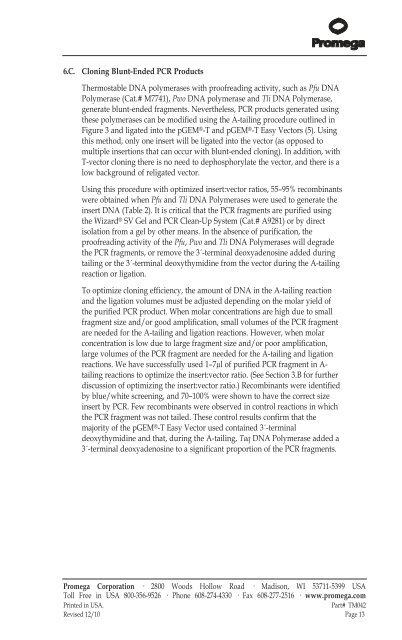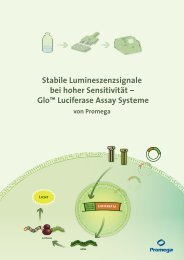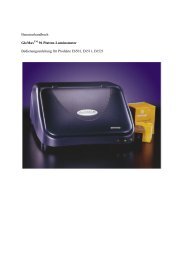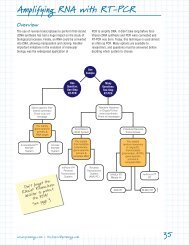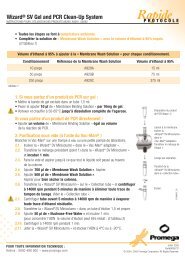pGEM-T and pGEM-T Easy Vector Systems Technical ... - Promega
pGEM-T and pGEM-T Easy Vector Systems Technical ... - Promega
pGEM-T and pGEM-T Easy Vector Systems Technical ... - Promega
Create successful ePaper yourself
Turn your PDF publications into a flip-book with our unique Google optimized e-Paper software.
6.C. Cloning Blunt-Ended PCR Products<br />
Thermostable DNA polymerases with proofreading activity, such as Pfu DNA<br />
Polymerase (Cat.# M7741), Pwo DNA polymerase <strong>and</strong> Tli DNA Polymerase,<br />
generate blunt-ended fragments. Nevertheless, PCR products generated using<br />
these polymerases can be modified using the A-tailing procedure outlined in<br />
Figure 3 <strong>and</strong> ligated into the <strong>pGEM</strong> ®-T <strong>and</strong> <strong>pGEM</strong> ®-T <strong>Easy</strong> <strong>Vector</strong>s (5). Using<br />
this method, only one insert will be ligated into the vector (as opposed to<br />
multiple insertions that can occur with blunt-ended cloning). In addition, with<br />
T-vector cloning there is no need to dephosphorylate the vector, <strong>and</strong> there is a<br />
low background of religated vector.<br />
Using this procedure with optimized insert:vector ratios, 55–95% recombinants<br />
were obtained when Pfu <strong>and</strong> Tli DNA Polymerases were used to generate the<br />
insert DNA (Table 2). It is critical that the PCR fragments are purified using<br />
the Wizard ® SV Gel <strong>and</strong> PCR Clean-Up System (Cat.# A9281) or by direct<br />
isolation from a gel by other means. In the absence of purification, the<br />
proofreading activity of the Pfu, Pwo <strong>and</strong> Tli DNA Polymerases will degrade<br />
the PCR fragments, or remove the 3´-terminal deoxyadenosine added during<br />
tailing or the 3´-terminal deoxythymidine from the vector during the A-tailing<br />
reaction or ligation.<br />
To optimize cloning efficiency, the amount of DNA in the A-tailing reaction<br />
<strong>and</strong> the ligation volumes must be adjusted depending on the molar yield of<br />
the purified PCR product. When molar concentrations are high due to small<br />
fragment size <strong>and</strong>/or good amplification, small volumes of the PCR fragment<br />
are needed for the A-tailing <strong>and</strong> ligation reactions. However, when molar<br />
concentration is low due to large fragment size <strong>and</strong>/or poor amplification,<br />
large volumes of the PCR fragment are needed for the A-tailing <strong>and</strong> ligation<br />
reactions. We have successfully used 1–7µl of purified PCR fragment in Atailing<br />
reactions to optimize the insert:vector ratio. (See Section 3.B for further<br />
discussion of optimizing the insert:vector ratio.) Recombinants were identified<br />
by blue/white screening, <strong>and</strong> 70–100% were shown to have the correct size<br />
insert by PCR. Few recombinants were observed in control reactions in which<br />
the PCR fragment was not tailed. These control results confirm that the<br />
majority of the <strong>pGEM</strong> ®-T <strong>Easy</strong> <strong>Vector</strong> used contained 3´-terminal<br />
deoxythymidine <strong>and</strong> that, during the A-tailing, Taq DNA Polymerase added a<br />
3´-terminal deoxyadenosine to a significant proportion of the PCR fragments.<br />
<strong>Promega</strong> Corporation · 2800 Woods Hollow Road · Madison, WI 53711-5399 USA<br />
Toll Free in USA 800-356-9526 · Phone 608-274-4330 · Fax 608-277-2516 · www.promega.com<br />
Printed in USA. Part# TM042<br />
Revised 12/10 Page 13


